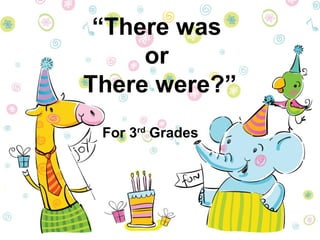
There was or there were?
- 1. “There was or There were?” For 3rd Grades
- 2. IMPORTANTE!!! • There was y There were son el pasado de «there is» y «there are». • Significan en español había – habían – hubo.
- 3. THERE WAS... There was se usa cuando hablamos de una cosa, es decir hablamos de un sustantivo singular. Este puede ser contable o incontable. Example: There was a pencil on the table. Había un lápiz sobre la mesa
- 4. THERE WERE... There were se usa cuando hablamos de dos cosas o más (sustantivos plurales). Estos sólo pueden ser contables. Example: There were three blind mice. Habían tres ratones ciegos.
- 5. Observemos ahora las formas negativas de there was y there were: There was There wasn't There were There weren't
- 6. There wasn't y There weren't significan en español: no había – no habían – no hubo Otras formas de escribirlos son: There wasn't There was not There weren't There were not
- 7. Observa las imágenes y lee las oraciones. Yesterday, there were 7 fish in the fish tank. Ayer habían 7 peces en la pecera. (Pero hoy hay sólo 3) Yesterday, there were 4 shells in the fish tank. Ayer habían 4 conchas en la pecera. (Pero hoy no hay ninguna concha)
- 8. Ahora que ocurre con oraciones negativas. Yesterday, there weren't 3 fish in the fish tank. Ayer no habían 3 peces en la pecera. (Sabemos que habían 7 peces y que hoy sólo hay 3) Yesterday, there wasn't a shell in the fish tank. Ayer no había una concha en la pecera. (Sabemos que ayer habían 4 conchas y no una sola; además hoy no hay ninguna)
- 9. Cuando queremos hacer preguntas con there was y there were debemos cambiar la posición de ambas palabras... There was Was there... ? There were Were there...? En ambos casos was y were deben ir primero que there.
- 10. En ambos casos was y were deben ir primero que there. Además también podemos usar como apoyo las palabras some y any . Some se usa en oraciones afirmativas. Any se usa en oraciones negativas o preguntas. Some significa en español algo de, algunos o algunas y Any (dependiendo si es en una oración negativa o pregunta) ninguno o alguno respectivamente.
- 11. Lee el siguiente texto y observa las preguntas. There was a school party yesterday. In the party there were some children in their customes, for example: there was a queen, there was a witch and there was a clown, but there wasn't any ghost. There weren't any balloons but there were a lot of sweets and fun!!!
- 12. Lee el siguiente texto y observa las preguntas. Había una fiesta en el colegio ayer. En la fiesta habían niños disfrazados, por ejemplo: había una reina, había una bruja y había un payaso, pero no había ningún fantasma. No habían globos, pero sí habían muchos dulces y diversión!!!
- 13. Ahora lee las siguientes preguntas y observa como se responden. 1. Was there any ghost? No, there wasn't. (¿Había algún fantasma? No, no había.) 2. Were there any children? Yes, there were. (¿Habían algunos niños? Sí, sí habían) 3. Was there a party at school? Yes, there was. (¿Había una fiesta en la escuela? Sí, sí había)
- 14. Ahora lee las siguientes preguntas y observa como se responden. 4. Were there any balloons? No, there weren't. (¿Habían algunos globos? No, no habían.) 5. Were there any sweets? Yes, there were. (¿Habían algunos dulces? Sí, sí habían) 6. Were there two clowns? No, there weren't. (¿Habían dos payasos? No, no habían.)
- 15. Material selected by Danitza Lazcano Flores Teacher of English Master in Education and Educational counselor
